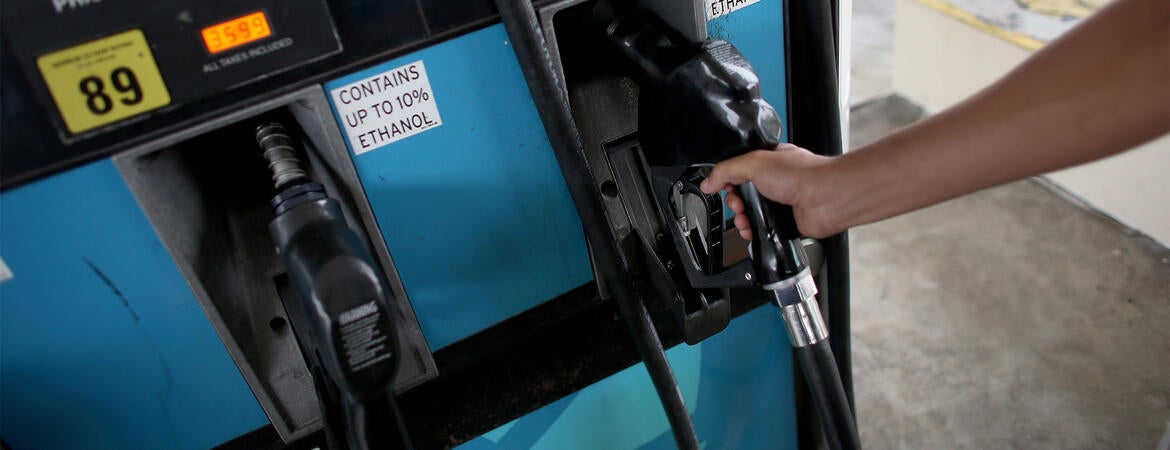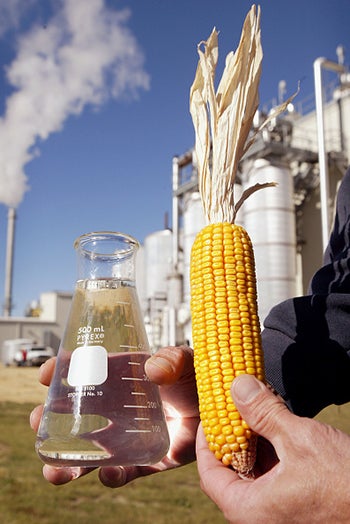
California residents will soon get some price relief at the pump and reductions in harmful vehicle emissions, thanks in part to a landmark UC Riverside vehicle emissions study.
Scientists at the university’s College of Engineering Center for Environmental Research and Technology, or CE-CERT, found that increasing the ethanol content in California gasoline from the allowable 10% to 15% cut harmful vehicle emissions, including small declines in nitrogen oxides (NOx), which are a primary precursor to ground-level ozone formation, and more significant reductions in particulate emissions.
The study, completed in 2023, was instrumental to Gov. Gavin Newsom’s approval of legislation this month to allow a 15% ethanol blend of gasoline at California fueling stations while the state continues research on whether the blend can meet state clean air requirements.
The 15% ethanol blend is also expected to reduce the price of a gallon by as much as 20 cents, a separate study by UC Berkeley and the U.S. Naval Academy found. This is because ethanol, made mostly from domestically grown corn and soybeans, is less costly than gasoline made from crude oil.
The UCR research was led by Georgios Karavalakis, a professor of chemical and environmental engineering, who oversaw state-of-the-art emission testing at CE-CERT, an off-campus research facility in Riverside on Columbia Avenue.
Karavalakis’ team first assembled a fleet of 20 passenger cars and light-duty trucks that was representative of the gasoline vehicles now on the state’s roadways.
“We carefully selected the vehicles to represent high-volume sales vehicles in California or vehicles of different standards,” Karavalakis said. “We wanted to get specific vehicles with specific standards and specific mileage.”
The researchers also carefully designed the test fuel so it would represent the kind of gasoline used throughout California. Karavalakis’ team collected gasoline samples from three different refineries in Southern California and one refinery in the Bay Area, then blended them together in equal amounts to create the final fuel used in the study.
The vehicles on each fuel were driven over repeated cycles on a testing device called a chassis dynamometer following federally accepted procedures.
While nitrogen oxides, a key ingredient in smog, showed no significant change, the study revealed that emissions of carbon monoxide, total hydrocarbons, and non-methane hydrocarbons declined with the E15 blend. Notably, emissions of particulate matter — tiny airborne particles that pose significant health risks — also dropped significantly when cars burned E15.
“Ethanol helps provide a much cleaner combustion because it has oxygen,” Karavalakis said. “That's why you have reductions in particulate emissions and in ultrafine particles, which are the very, very small particles that can be easily inhaled. They can also penetrate very deep in your respiratory system.”
The findings carry implications for California’s long-standing ethanol blend wall — a regulatory cap that limits ethanol content in gasoline to 10%. The state has been cautious about raising the limit due to concerns about air pollution in regions like the South Coast Air Basin and the San Joaquin Valley, which regularly fail to meet federal smog and particulate standards.
The study’s evidence may help regulators reconsider.
“Higher ethanol blends, as well as other low-carbon and zero-carbon biofuels, must be part of the mix for a sustainable and clean transport sector that will coexist with other proven clean technologies, such as battery electric vehicles,” Karavalakis said.
Karavalakis said the impacts go beyond saving a few dollars at the pump.
“It’s not only the consumer, but the industry as well,” he said. “We're talking about a domestically produced biofuel by American farmers that they will now have to produce more of to meet the needs of California. This practice will also contribute to energy security.”
Because ethanol is renewable, it has a lower carbon footprint than unblended gasoline. It is typically made from corn or cellulosic biomass. Its combustion releases carbon dioxide that was absorbed from the atmosphere during plant growth, effectively recycling carbon rather than adding new fossil-based carbon dioxide to the atmosphere.
Though California has restricted ethanol content in gasoline to 10%, the U.S. Environmental Protection Agency allows E15 for use in all 2001 and newer vehicles, and the E15 blend is available in 31 states at over 3,000 gas stations. The UCR study may provide the kind of data state regulators need to support broader E15 adoption in California.
The UCR study was published in the journal Fuel and is available online.
The title of Karavalakis’ paper is “Expanding the ethanol blend wall in California: Emissions comparison.” Published in the journal Fuel by Elsevier LTD, the UCR co-authors are Tianbo Tang, Cavan McCaffery, Tianyi Ma, Peng Hao, Thomas Durbin, and Kent Johnson.
“There’s growing momentum to expand the use of lower-carbon fuels in California,” Karavalakis said. “This study shows that doing so can bring real emissions benefits — not just in theory, but on the road.”





